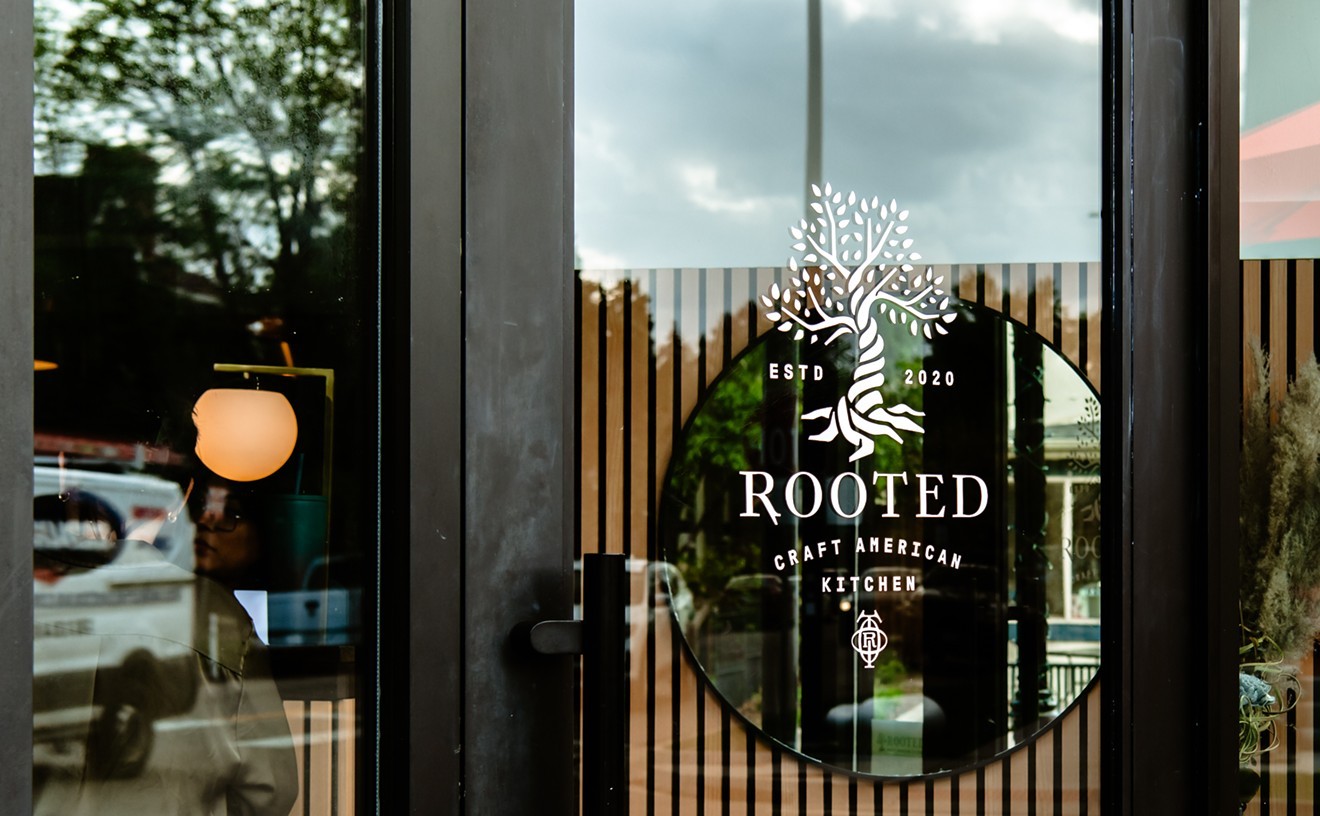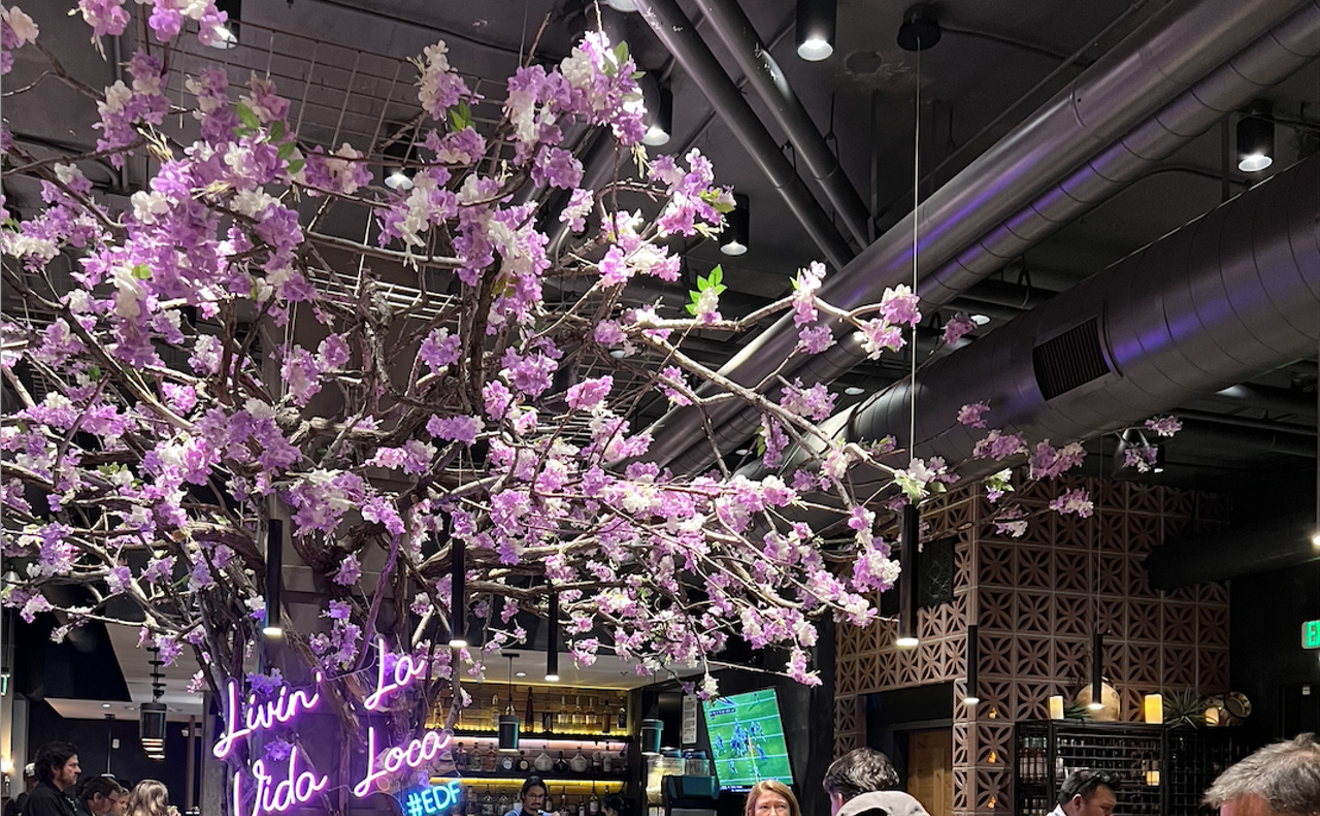But four months after Todai opened in the Cherry Creek Shopping Center, curiosity finally got the best of me. An acquaintance was visiting from Florida, and a 150-foot, 100-item seafood buffet in a mall seemed just the place to take him in landlocked Denver. He felt right at home--not just because he's incredibly cheap and Florida's the land of all-you-can-eat spreads, but also because Todai has such a Jetsons-at-the-beach look.
The vast, mall-side dining room features spacy, neon-ringed pillars, star-like lights set into the ceiling and a food station that looks like an aluminum pagoda about to be beamed up. This unlikely ambience is further accessorized by pictures of oversized sea creatures on the walls and cafeteria-style seating, with easy-to-clean laminated tables and avocado vinyl chairs. But the buffet is the focal point, and it's as vast as the ocean. Or close, anyway: It covers two walls and looks to be about the equivalent of fifteen Wendy's salad bars.
Just waiting to get at this is an unlikely horde of diners that includes buffet buffs and sushi fans, who tend to have a certain hipness that the big-bellied, all-you-can-eat fans do not. They start lining up well before the place opens at 5:30 p.m. for dinner ($20.95 weekdays, $21.95 on weekends and holidays; there's also a lunch buffet for $11.95 weekdays and $13.95 weekends). As the doors swing open, the manager begins to ceremoniously shuffle people in, matching them with a host who seats them, takes their drink orders and then sets them adrift in the direction of the buffet.
Man overboard!
Like almost everyone else at Todai, we headed for the raw spread first. I counted almost thirty types of sushi, including shrimp, red snapper, yellowtail and salmon; over a dozen rolls, with an emphasis on Krab and avocado; and eight varieties of sashimi--including mackerel, octopus, tuna and salmon--as well as scallops and mussels on the half-shell. While the fish tasted fresh, the flesh was barely sushi quality, and the selections were astoundingly bland: If you closed your eyes, you couldn't tell if you were eating tuna or yellowtail or cardboard. (No wonder that sitting next to the sushi is a bowl the size of a wok filled to the brim with wasabi.) My toddler could have cut more aesthetically pleasing pieces with a pair of safety scissors: Some of the sashimi had unappetizing strings hanging off it, and the odd sushi proportions made many of the raw slices look like big, floppy fish stranded on white rocks. In fact, the sushi rice came close to stone-like consistency; it was packed tighter than a carry-on bag at DIA.
But all-you-can eat is rarely about aesthetics. If you like mediocre sushi, you can probably eat your money's worth at Todai. Just steer clear of the salmon-skin roll if it smells as rank as it did on one of my visits.
Less chancy are the salads, all rather healthy and some very Asian. Of the dozens on display, we liked the kimchi best--it contained more expensive romaine rather than the cheaper lettuce you find at Korean restaurants and was also packed with flavor and spices. Although the Caesar was a little overdressed, it wasn't bad, either; and the endive shards filled with mayo-moistened Krab had a certain appeal.
But as with the sushi, many of the salad selections were incredibly bland. Exhibit A: a watery "cabbage salad" that was nothing more than shredded green cabbage, slices of unadorned tofu and cauliflower speckled with some unidentifiable red substance. And those salads that did taste offered variations on a sugar-sweetened-soy-sauce theme. Exhibit B: a salad of otherwise well-poached asparagus, edamame pods and something called jabara cucumbers--which looked like whole cucumbers attacked on their undersides with a knife (what happened to the creative carving Japanese cuisine is known for?)--ruined by a soaking in the sweet sauce. Cucumbers were almost as ubiquitous: We sampled a "summer" salad of cukes and an "artichoke" salad that had forty cucumber slices for every artichoke heart. But over two visits, I never saw a soul touch the dark-green, sesame-studded, slimy-looking "cooked seaweed" salad. And despite the helpful label, I didn't, either.
Next stop: the space-age pagoda, which featured every fruit imaginable--including Bing cherries--as well as more seafood. We sampled an adequate "pouched salmon," almost drowned in the water that oozed from the previously frozen stone crab claws, skipped the shriveled raw oysters and fled from a stinky marinated salmon.
On to the hot-food section, which specializes in more seafood, here smothered in pasteurized processed cheese product. The "king salmon" selection might have pleased the ruler of Wisconsin, but no one else: A whole baked fish had been covered very neatly in slices of shiny American cheese, then surrounded by mashed potatoes so dry they had the texture of marshmallows. The "jumbo shrimp" were jumbo disasters: gutted shrimp shells stuffed with an unsettling cheesy substance that may or may not have involved shrimp. The "sward fish" consisted of fillets the thickness of veal cutlets that had been fried in lots of imitation butter, then sided with more of those dreadful potatoes. And then there was the inscrutable "crab boy": a crab shell filled with a mayo-like cheese goo that had been baked until a film formed on top. Yum! There may have been actual strands of crab inside, but I was too frightened to go there.
More recognizable were the hot line's land-based dishes. I nibbled on paper-thin fatty beef shreds in a sukiyaki (read: glucose-infused) sauce and little rectangles of beef in a teriyaki (read: glucose-infused) sauce. And then there were hacked-up chicken parts with inch-thick layers of skin fat in a (glucose-infused) barbecue sauce that appeared to have been applied with one stroke of a Q-Tip.
But there's more, so much more, to Todai. For example, there was an inexplicable French onion soup that came in a cute little crock topped with cheap, oily puff pastry; beneath the lid sat a spoonful of mushroom broth, two onion shreds and no cheese, oddly enough (perhaps the kitchen had exhausted its allotment on the fish). A better broth was waiting to be poured into the noodle bowls, which had already been filled with udon, half a fish cake, one mushroom cap and scads of scallions. The soup ingredients were so dry and shriveled, they'd obviously been sitting out for a while. The miso soup was wet enough, though, with blobs of wet, tempura-like batter floating on top. And those blah blobs were tastier than the real tempura--shrimp and vegetables that had been fried in batter, then set beneath the heat lamps to slowly dry into briquettes.
We held fast and prayed that dessert would be a lifesaver. Buffets usually outdo themselves on the final course: They want diners to leave feeling good and contemplating a quick return to the establishment. But Todai's confections were unsatisfying and silly-looking (imagine grown men in a cafeteria with a plate of petit-fours). If you love goo, these inch-square cubes are for you: a dozen variations of sugary cake layered with fruit-flavored slime and slicked with a gelatin topping. There was also real Jell-O, orange and green and as warm as a kiddie pool but somehow still solid.
Ah, the mysteries of the Orient.
My meals at Todai raised more questions than they answered. For starters: Just what are the owners thinking? But it's easier to satisfy your hunger at Todai than it is to satisfy your curiosity. My calls finally landed at the California office of Paul San, the general manager of KM Seafood Company, which turns out to be the owner of Todai and the likely source of fish for the restaurants. San said he would fax over some information, but it was all in his briefcase, which was in his car, which was in the shop. "I will fax you tomorrow," he said. He never did.
In Japan, "todai" means lighthouse--but I'm in the dark as to why people keep coming to this restaurant.
Todai, 300 East First Avenue, 303-393-9114. Hours: 11:30 a.m.-2:30 p.m., 5:30-9 p.m. Monday-Thursday; 11:30 a.m.-3 p.m., 5:30-10 p.m. Friday; 11:30 a.m.-3 p.m., 5-10 p.m. Saturday; 11:30 a.m.-3 p.m., 5-9 p.m. Sunday.










